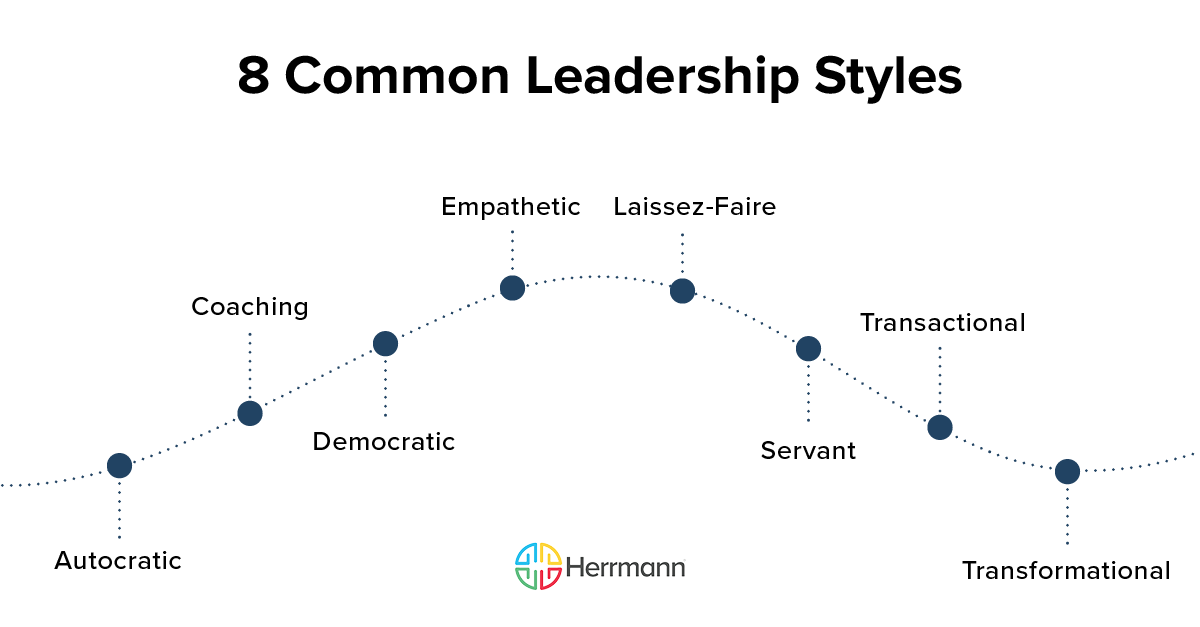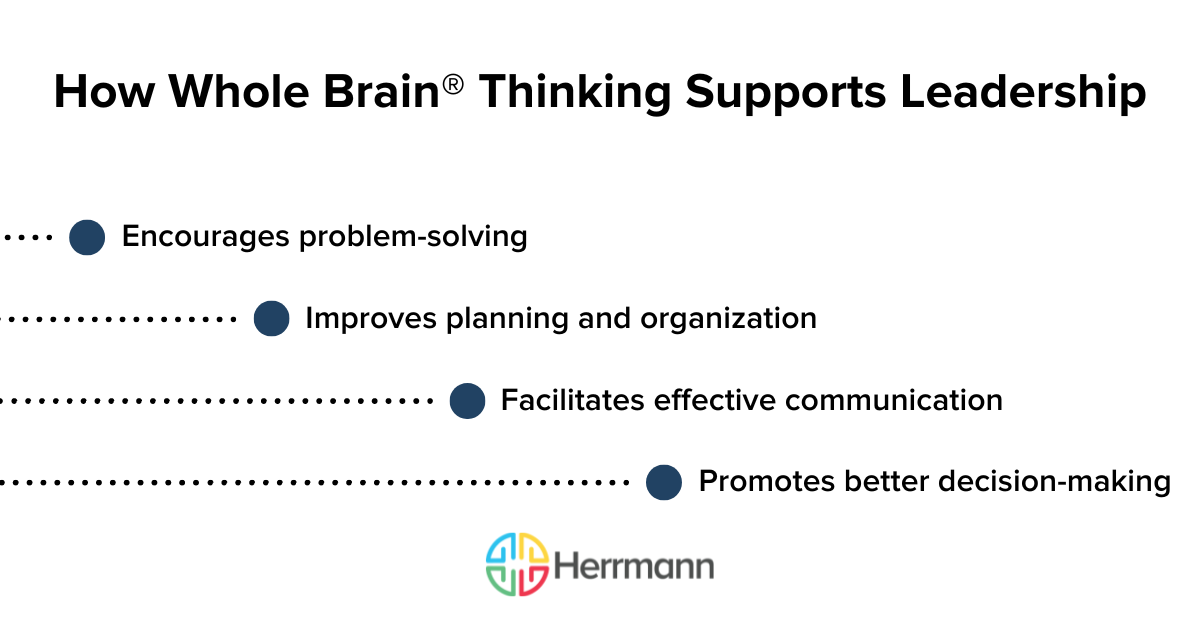Great leaders know how to inspire and motivate their teams as a collective while bringing out each team member’s individual strengths. But this outcome is less the result of choosing the best leadership styles and more about understanding the specifics of you, your team, and the working environment you’re operating in.
For example, a survey by the Niagara Institute found that democratic leadership was the preference of nearly 47% of professionals. But just because you don’t practice a democratic leadership style doesn’t mean you can’t lead by example, collaborate on decision-making, or grant creative freedom and autonomy — the top three leadership strengths cited by respondents. While identifying the most effective leadership styles can be informative for leaders and employees alike, it’s only one step toward great leadership.
Learn more about defining effective leadership, why leadership styles are important but not absolute, and how Whole Brain® Thinking can help you become a more effective team leader.
What Is Effective Leadership?
Leadership is a complex activity, requiring a combination of skills, experience, and adaptability based on circumstances and the people involved. At its core, effective leadership is about guiding and motivating individuals, teams, and organizations to achieve goals.
Effective leadership is driven by self-awareness and understanding — leaders must recognize their strengths and weaknesses before they can help others. They must also be perceptive of the environment and their employees’ strengths, weaknesses, and needs. These leaders must be able to diagnose the challenges, lay a course toward goals, and motivate others to come along with them.
Effective workplace leaders contribute to increased productivity, efficiency, morale, loyalty, and innovation. Managers are the biggest factor affecting employee performance, according to Gallup, and the success of your organization likely depends on whether you can attract, develop, and retain strong managers.
One way to think about effective leadership is as an archetype — a singular definition of how a great leader looks, thinks, speaks, and behaves. But most effective leaders don’t have a single approach to leadership. Rather, they assess the situation and adjust their leadership approach to fit the needs of their team.
Businesses are continuously changing, and so are the expectations of employees. Not every employee responds positively to the same types of feedback, direction, or motivation. Thus no one leadership style is likely to be effective for every employee — or every leader.
8 Common Leadership Styles
There are many different leadership styles, each with its own strengths and weaknesses. Here are nine such styles and how they can be used to get the most out of a team.
Autocratic
Autocratic leaders dictate what their team should do, both in terms of tasks and philosophy. They make decisions solely based on personal authority and experience. This approach can deliver effective leadership during a crisis when decisive, quick actions are required. Autocratic leadership can also be effective, for example, when the leader is the subject matter expert and needs to give direct orders. However, this approach over time can lead to employees feeling undervalued and underappreciated, especially when their expertise isn't recognized or considered.
Coaching
Coaching leaders take a mentorship approach, offering guidance instead of giving explicit direction. They focus on empowering team members to devise solutions rather than telling them what to do. Coaching-focused environments can help employees grow into their roles while holding them accountable for making progress and delivering results.
This approach requires close relationships, regular communication between leader and employee, and an emphasis on skill-building. With large teams, this approach can become more difficult if the leader is trying to coach many people at once individually.
Democratic
Sign up to our newsletter for the latest insights
Empathetic
Empathetic leaders focus on understanding each person’s needs and point of view before making decisions. While facts and data are still part of the process, these leaders emphasize the impact on their people. They build strong relationships with their team members and strive for a workplace where everyone is listened to, respected, and appreciated..
Laissez-Faire
Laissez-faire leadership provides minimal guidance and direction. These leaders choose to allow maximum freedom for employees whenever possible. This style of leadership is based on the belief that workers are motivated when they can take initiative and make their own decisions.
As such, laissez-faire leaders act as facilitators, providing resources, guidance, and support while leaving most decision-making to employees.
Servant
Servant leadership, created by Robert K. Greenleaf, combines a natural desire to serve others with deliberate choices that serve people’s highest needs. These leaders put their team’s interests ahead of their own desires. This type works well when building trust within a group, as servant leaders can quickly illustrate their commitment to individuals and the team, not just their own interests.
Transactional
Transactional leadership uses sticks and carrots to motivate team members. The focus is on setting clear goals and providing instructions on how to reach them. Transactional leaders usually offer incentives for reaching those goals while laying out the consequences for failure. This style works well when dealing with tasks that require structure, routine, and stability. However, it’s not always conducive to building trusting relationships or helping people feel like they’re part of a close-knit team.
Transformational
Transformational leaders inspire their teams through a shared vision and helping each person understand how they fit into it. These leaders inspire loyalty by being positive role models who demonstrate respect for individual contributions while pushing each person toward higher levels of workplace excellence.
Transformational leadership works well when trying to create an environment of creativity, innovation, and collaboration, as it encourages people to think outside the box while still working together toward common goals.

How Whole Brain® Thinking Supports Effective Leadership
Inclusive leadership starts with you. No matter which style you prefer, you need to understand how you think, how your team thinks, and how those similarities and differences can be harnessed for better thinking, collaboration, and business results.
The Whole Brain® Thinking Model and Herrmann Brain Dominance Instrument® (HBDI®) assessment can help leaders think more deeply about their leadership style and how to best use it for the team’s benefit.
Whole Brain® Thinking is a framework backed by over 40 years of experience that identifies how people think and what works best aligns with their preferences. The HBDI® assessment divides people’s thinking preferences into four quadrants: Analytical (Blue), Structural (Green), Relational (Red), and Experimental (Yellow). While everyone has a higher preference for one or two quadrants, everyone can and does access all four quadrants daily. Importantly, no quadrant or combination of quadrants is superior to another.
Here are a few ways Whole Brain® Thinking can help leaders be more effective.
Problem-Solving
Whole Brain® Thinking helps leaders lead their teams through structured problem-solving exercises that examine problems in various ways. For example, you might walk through a problem with these questions:
- What? This analytical (Blue) approach ascertains the facts and conditions.
- How? This structural (Green) question tries to organize the problem, including what processes are involved and what steps should be taken (or have been).
- Who? This interpersonal (Red) question doesn’t just seek to catalog who’s involved. It considers how each person or job role is affected by the problem and by possible remedies.
- Why? This experimental (Yellow) approach attempts to figure out the cause(s) of the problem — and how it might be redefined to find creative solutions.
Improved Planning and Organization
One of the biggest challenges for many leaders is keeping teams organized, especially when planning complex initiatives. Understanding your team’s thinking preferences can help you craft well-rounded planning documents that account for key details while also connecting with people’s preferences.
For example, if you’re designing standard operating procedures (SOPs) for your team, you’ll need to list steps and actions to take, as well as systems, processes, or tools to use. Structural (Green) thinking of this kind is essential. But go further by indicating why these SOPs are being created (Yellow) and how you’ll measure success and key results (Blue).
Additionally, while these SOPs will indicate who does what, they go beyond faceless roles. Indicate the positive effects the employees in these job roles (Red) will gain by following these procedures. Those gains could be increased productivity, less frustration, better communication, or countless other possibilities.
Effective Communication
Communication is all about gaining a shared understanding. Whole Brain® Thinking helps your team embrace differences in thinking preferences to develop common understanding and a shared language that facilitates honest, open, and constructive communication.
One example of how leaders can reinforce better communication is by understanding how their people receive information best. While much information must be written down, visuals or audio can help many people retain key information better.
Better Decision-Making
Understanding your team's thinking preferences can help you make better decisions that are more likely to align with business goals. By being aware of your team’s strengths, weaknesses, and thinking preferences, you can tailor decision-making processes to ensure the best possible outcomes and most efficient working methods.
Cirque du Soleil used Whole Brain® Thinking to unlock the diversity of thinking inside the organization without sacrificing the flat leadership structure it valued so dearly.
“I would ask, ‘What would make your team smarter? Stronger?’ The answers are always in their diversity of thought,” says consultant Danièle Bienvenue. “And so Whole Brain® Thinking became a pillar, a lighthouse constantly reminding us of this knowledge about members of the team. We focused on how we can use these insights to make better decisions.”

Be the Leader Your Team Needs And Wants
The best leadership styles aren't a one-size-fits-all approach. The best types of leaders recognize the needs and strengths of their employees and adjust their style accordingly. By embracing adaptability and differences in thinking, leaders can bring their teams closer, maximize their potential, and deliver better organizational results.
Discover how to harness your team’s cognitive diversity to create a more resilient organization.












